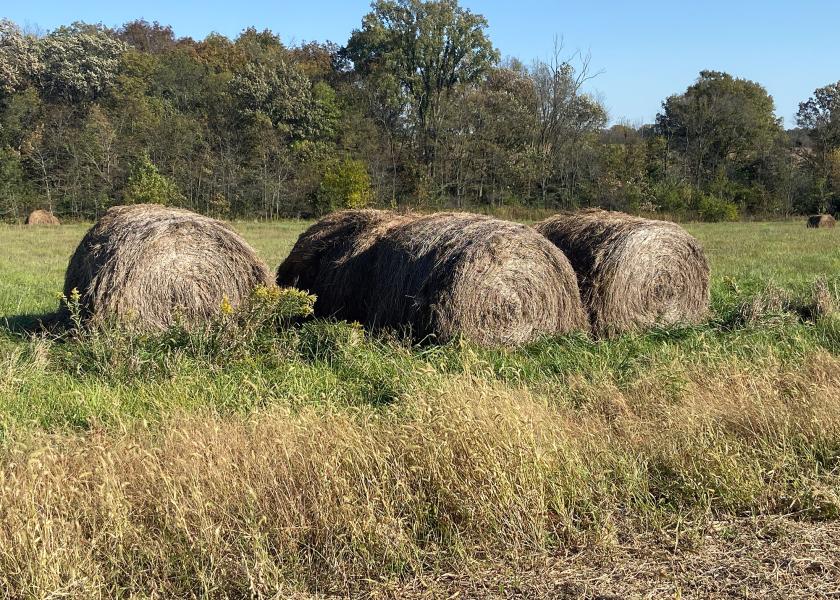What to Feed When There's Nothing to Feed

Many Missouri beef producers found themselves trying to pull a rabbit out of the hat as they rang in 2024 with low hay supplies, says University of Missouri Extension beef nutrition specialist Eric Bailey. He says post-drought feeding woes leave producers challenged with “what to feed when there is no feed.”
The severity of the drought in 2022 and 2023 may have been underrated, he says. Many areas of the state faced precipitation deficits of 12-20 inches in mid-November before entering winter – typically the driest season of the year. Mid-Missouri was among the hardest-hit areas, with 80% less precipitation than normal, but drought ravaged pastures throughout the state.
Effects of those deficits continue to carry over for the 43,000 Missouri cattle farms and ranches. Bailey says producers should strive to hold winter feeding costs to $5 or less per cow per day.
Bailey urges producers to look at their total mixed ration (TMR) to ensure that cattle receive adequate nutrition for good health, milk production and reproduction in the days ahead. TDN needs differ for lactating (62%) and (55%) dry cows.
Feed cows based on nutrient requirements, rather than appetite. Ask if bellowing cows are hungry or just wanting. Limit intake slightly – from 2.5% to 2.0% of body weight per day. Small reductions such as this should lower your feed bill but not adversely affect the cow’s health.
Bailey offers these tips for stretching your feed during the next few months:
• Check out MU Extension’s new Feedstuff Finder at https://feedstufffinder.org. The platform helps producers and consumers of feedstuffs find one another, cut transportation costs and manage tight winter feed supplies when feed costs and availability can be volatile.
• Switch up the menu based on your budget. Consider the cost of feeding hay vs. corn. Corn prices are low at the present and prices are high for hay, even poor-quality hay that may not offer good nutrition. Put a pencil to it and figure out which provides the most nutrition for the dollar.
• Reduce hay waste.
• Consider investing in farm infrastructure. This might be a good time to consider investing in covered storage for hay to reduce waste. Fences and watering systems can allow grazing of cornstalks.
• Ask if feed savings will offset paying for a mixer. Assuming you have a tractor, you can save $50 per cow. “Even if you have 100 cows, that’s a huge savings,” says Bailey.
• Always, always, always, look at your stocking rate and be ready to hitch the trailer. You can feed corn silage without a mixer as a high-nutrient, high-waste alternative. Exposure to air increases spoilage and decreases feed value and palatability. Knowing how the silage was put up will help you determine if it is a good value. If it smells like dirty feet, walk away.
Figure dry ton costs for the best deal. Corn silage at $80 per ton and at 35% dry matter amounts to $228.57 per dry ton. Corn at $5.32 per bushel is $223.54 per dry ton, and soyhulls at 13 cents per pound is $288.88 per dry ton.
Consider feeding cornstalks if you have fencing and a water supply. Limit cows to grazing cornstalks for two months or less, and allow an acre per cow per month. Protein intake is limited after the first 30 days on the same field as cows eat their way through leaves, husk and, finally, stalks and cobs. Also, consider soil compaction caused by grazing cattle.
The nutrient value of grazed cornstalks diminishes with time and need to be supplemented. Bailey recommends supplementing with 5 pounds of a 14% commodity mix per cow per day. The goal is to get 0.75 pounds of crude protein per cow per day.
He recommends guidance from your regional MU Extension livestock specialist and these resources from the University of Nebraska:
- “Grazing Corn Stalks or Corn Residue?” https://beef.unl.edu/beefwatch/2020/grazing-corn-stalks-or-corn-residue
- “Keys for Corn Stalk Grazing,” https://beef.unl.edu/keys-corn-stalk-grazing
- “Corn Stalk Grazing Calculator,” https://beef.unl.edu/learning/cornstalkgrazingcalc.shtml
Ammoniation of less palatable hay or straw also is an option. See https://extension.missouri.edu/news/ammoniation-stretches-hay-supplies-during-drought.
Another option in some parts of the state is cotton gin trash, which is the residual seeds, bolls, leaves and stems of the cotton plant left after harvest.
Learn more about calculating winter feed costs for beef cows at https://extension.missouri.edu/news/calculating-winter-feed-costs-for-beef-cows. You may also contact your regional MU Extension livestock specialist.







